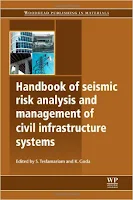Smoothed Finite Element Methods
 G. R. Liu, Nguyen Thoi Trung ...
G. R. Liu, Nguyen Thoi Trung ... 691 pages -Publisher: CRC Press; 1st edition (June 8, 2010)
Language: English - ISBN-10: 1439820279 - ISBN-13: 978-1439820278
Generating a quality finite element mesh is
difficult and often very time-consuming. Mesh-free methods operations
can also be complicated and quite costly in terms of computational
effort and resources. Developed by the authors and their colleagues, the
smoothed finite element method (S-FEM) only requires a
triangular/tetrahedral mesh to achieve more accurate results, a
generally higher convergence rate in energy without increasing
computational cost, and easier auto-meshing of the problem domain.
Drawing on the authors’ extensive research results, Smoothed Finite Element Methods presents the theoretical framework and development of various S-FEM models.
After introducing background material, basic equations, and an abstracted version of the FEM, the book discusses the overall modeling procedure, fundamental theories, error assessment matters, and necessary building blocks to construct useful S-FEM models. It then focuses on several specific S-FEM models, including cell-based (CS-FEM), node-based (NS-FEM), edge-based (ES-FEM), face-based (FS-FEM), and a combination of FEM and NS-FEM (αFEM). These models are then applied to a wide range of physical problems in solid mechanics, fracture mechanics, viscoelastoplasticity, plates, piezoelectric structures, heat transfer, and structural acoustics.
Requiring no previous knowledge of FEM, this book shows how computational methods and numerical techniques like the S-FEM help in the design and analysis of advanced engineering systems in rapid and cost-effective ways since the modeling and simulation can be performed automatically in a virtual environment without physically building the system. Readers can easily apply the methods presented in the text to their own engineering problems for reliable and certified solutions.
After introducing background material, basic equations, and an abstracted version of the FEM, the book discusses the overall modeling procedure, fundamental theories, error assessment matters, and necessary building blocks to construct useful S-FEM models. It then focuses on several specific S-FEM models, including cell-based (CS-FEM), node-based (NS-FEM), edge-based (ES-FEM), face-based (FS-FEM), and a combination of FEM and NS-FEM (αFEM). These models are then applied to a wide range of physical problems in solid mechanics, fracture mechanics, viscoelastoplasticity, plates, piezoelectric structures, heat transfer, and structural acoustics.
Requiring no previous knowledge of FEM, this book shows how computational methods and numerical techniques like the S-FEM help in the design and analysis of advanced engineering systems in rapid and cost-effective ways since the modeling and simulation can be performed automatically in a virtual environment without physically building the system. Readers can easily apply the methods presented in the text to their own engineering problems for reliable and certified solutions.











































